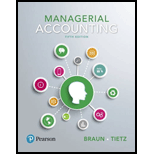
Managerial Accounting (5th Edition)
5th Edition
ISBN: 9780134128528
Author: Karen W. Braun, Wendy M. Tietz
Publisher: PEARSON
expand_more
expand_more
format_list_bulleted
Textbook Question
Chapter 4, Problem 5QC
(Learning Objective 3) The potential benefits of ABC/ABM are generally higher for companies that
- a. produce high volumes of some products and low volumes of other products.
- b. have low
manufacturing overhead costs. - c. are in noncompetitive markets.
- d. produce one product.
Expert Solution & Answer
Want to see the full answer?
Check out a sample textbook solution
Students have asked these similar questions
Financial Accounting
I need the correct answer to this financial accounting problem using the standard accounting approach.
hello dear tutor If submitted blurr comment i will write values.
please dont Solve with incorrect values otherwise unhelpful.
Chapter 4 Solutions
Managerial Accounting (5th Edition)
Ch. 4 - (Learning Objective 1) Cost distortion is more...Ch. 4 - (Learning Objective 2) The first step in computing...Ch. 4 - (Learning Objective 2) Activities incurred...Ch. 4 - (Learning Objective 3) Which of the following is...Ch. 4 - (Learning Objective 3) The potential benefits of...Ch. 4 - (Learning Objective 4) Lean operations are...Ch. 4 - Prob. 7QCCh. 4 - (Learning Objective 4) Concerning lean operations,...Ch. 4 - (Learning Objective 5) Which of the following is...Ch. 4 - (Learning Objective 5) Which of the following...
Ch. 4 - Understanding key terms (Learning Objectives 1, 2,...Ch. 4 - Use departmental overhead rates to allocate...Ch. 4 - Compute departmental overhead rates (Learning...Ch. 4 - Prob. 4.4SECh. 4 - Prob. 4.5SECh. 4 - Calculate a job cost using ABC (Learning Objective...Ch. 4 - Classifying costs within the cost hierarchy...Ch. 4 - Classifying costs within the cost hierarchy...Ch. 4 - Determine the usefulness of refined costing...Ch. 4 - Prob. 4.10SECh. 4 - Identifying costs as value-added or...Ch. 4 - Identify lean production characteristics (Learning...Ch. 4 - Identify the DOWNTIME activities at a manufacturer...Ch. 4 - Prob. 4.14SECh. 4 - Classifying costs of quality (Learning Objective...Ch. 4 - Quality initiative decision (Learning Objective 5)...Ch. 4 - Assess the impact of a quality initiative...Ch. 4 - Identify ethical standards violated (Learning...Ch. 4 - Compare traditional and departmental cost...Ch. 4 - Compute activity rates and apply to jobs (Learning...Ch. 4 - Apply activity cost allocation rates (Learning...Ch. 4 - Using ABC to bill clients at a service firm...Ch. 4 - Compare traditional and ABC allocations at a...Ch. 4 - Compare traditional and ABC allocations on a job...Ch. 4 - Use ABC to allocate manufacturing overhead...Ch. 4 - Continuation of E4-25A: Determine product...Ch. 4 - Prob. 4.27AECh. 4 - Classify costs and make a quality-initiative...Ch. 4 - Prob. 4.29AECh. 4 - Compare traditional and departmental cost...Ch. 4 - Prob. 4.31BECh. 4 - Prob. 4.32BECh. 4 - Prob. 4.33BECh. 4 - Compare traditional and ABC cost allocations at a...Ch. 4 - Prob. 4.35BECh. 4 - Prob. 4.36BECh. 4 - Prob. 4.37BECh. 4 - Prob. 4.38BECh. 4 - Classify costs and make a quality-initiative...Ch. 4 - Prob. 4.40BECh. 4 - Prob. 4.41APCh. 4 - Use ABC to compute full product costs (Learning...Ch. 4 - Prob. 4.43APCh. 4 - Prob. 4.44APCh. 4 - Prob. 4.45APCh. 4 - Prob. 4.46BPCh. 4 - Prob. 4.47BPCh. 4 - Comprehensive ABC implementation (Learning...Ch. 4 - Using ABC in conjunction with quality decisions...Ch. 4 - Comprehensive ABC (Learning Objectives 2 3)...Ch. 4 - Prob. 4.51SCCh. 4 - Discussion Questions 1. Explain why departmental...Ch. 4 - ABC in Real Companies Choose a company in any of...Ch. 4 - Value-Added versus Non-Value-Added at a Restaurant...Ch. 4 - Ethics involved with ABC and hazardous waste costs...
Knowledge Booster
Learn more about
Need a deep-dive on the concept behind this application? Look no further. Learn more about this topic, accounting and related others by exploring similar questions and additional content below.Similar questions
arrow_back_ios
SEE MORE QUESTIONS
arrow_forward_ios
Recommended textbooks for you
 Cornerstones of Cost Management (Cornerstones Ser...AccountingISBN:9781305970663Author:Don R. Hansen, Maryanne M. MowenPublisher:Cengage LearningPrinciples of Accounting Volume 2AccountingISBN:9781947172609Author:OpenStaxPublisher:OpenStax College
Cornerstones of Cost Management (Cornerstones Ser...AccountingISBN:9781305970663Author:Don R. Hansen, Maryanne M. MowenPublisher:Cengage LearningPrinciples of Accounting Volume 2AccountingISBN:9781947172609Author:OpenStaxPublisher:OpenStax College Managerial Accounting: The Cornerstone of Busines...AccountingISBN:9781337115773Author:Maryanne M. Mowen, Don R. Hansen, Dan L. HeitgerPublisher:Cengage Learning
Managerial Accounting: The Cornerstone of Busines...AccountingISBN:9781337115773Author:Maryanne M. Mowen, Don R. Hansen, Dan L. HeitgerPublisher:Cengage Learning

Cornerstones of Cost Management (Cornerstones Ser...
Accounting
ISBN:9781305970663
Author:Don R. Hansen, Maryanne M. Mowen
Publisher:Cengage Learning

Principles of Accounting Volume 2
Accounting
ISBN:9781947172609
Author:OpenStax
Publisher:OpenStax College

Managerial Accounting: The Cornerstone of Busines...
Accounting
ISBN:9781337115773
Author:Maryanne M. Mowen, Don R. Hansen, Dan L. Heitger
Publisher:Cengage Learning
Relevant Costing Explained; Author: Kaplan UK;https://www.youtube.com/watch?v=hnsh3hlJAkI;License: Standard Youtube License